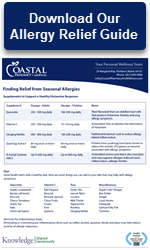
The advent of spring means the arrival of higher pollen counts and, unfortunately for some, bad allergies. To enjoy the season with less discomfort, our pharmacists and wellness specialists offer a few conventional and natural options for relief.
Note: It’s important to talk to your doctor about the different medication options and ask your pharmacist about interactions and cautions when taking them. Always disclose other health conditions, such as high blood pressure, hyperthyroidism, or cardiovascular disease, when discussing medication options.
OVER-THE-COUNTER AND PRESCRIPTION MEDICATION
Allergy Medication Classes
Allergy medications come in different classes: antihistamines, decongestants, corticosteroids, and mast cell stabilizers. Antihistamines, decongestants, corticosteroids, and mast cell stabilizer nasal sprays are available over-the-counter (OTC). There are also some steroid nasal sprays that require a prescription.
Additionally, there are some over-the-counter allergy medications that are a combination of the different classes, such as antihistamine and decongestant tablets. Although many allergy medication classes can be used alone, some people have symptoms that require a combination of products based on their symptoms. A pharmacist or doctor can help you determine the best for your symptoms.
Antihistamines
Antihistamines, as the name implies, block histamine. Histamine is a chemical that is released by our body’s mast cells during an allergic reaction. It is what causes the symptoms you’re experiencing due to the immune system response it triggers (itching, runny nose, and swelling of nasal tissue).
Histamine is also found in some plants and insect venom and ironically produces a histamine reaction when contacting human tissue. Antihistamines work by blocking the chemicals that cause the symptoms in the first place. Antihistamines are all available over-the-counter.
Examples
- Benadryl (diphenhydramine)
- Claritin (loratadine)
- Allegra (fexofenadine)
- Zyrtec (cetirizine)
Decongestants
Decongestants work by reducing the swelling in your nasal tissues. This relieves the pressure and allows more room for air to flow. They come in a number of forms: pills, liquids, nasal sprays, and drops. They can have a number of side effects, dosing precautions, and contraindications, so discuss with a pharmacist or doctor if you have concerns.
- Afrin (oxymetazoline)
- Dristan (oxymetazoline-menthol)
- Sudafed PE and Suphedrin PE (phenylephrine)
- Sudafed (pseudoephedrine)
Examples of Combination Antihistamine/Decongestant
- Zyrtec-D (cetirizine and pseudoephedrine)
- Clarinex-D (desloratadine and pseudoephedrine)
- Allegra-D (fexofenadine and pseudoephedrine)
- Claritin-D (loratadine and pseudoephedrine)
These combination products are available as a 12-hour or 24-hour formula, minimizing or eliminating the need for multiple doses a day.
Mast Cell Stabilizers
As previously stated, histamine is released by mast cells. Whereas antihistamines block histamine itself, mast cell stabilizers block the release of histamine. They’re commonly used when antihistamines don’t work or aren’t well-tolerated. They come in nasal sprays and eye drops.
Examples
- Nasalcrom Nasal Spray (cromolyn)
- Naphcon-A Eye Drops (naphazoline)
Corticosteroids
Nasal corticosteroids work by reducing the allergic responses of several cell types, including mast cells and eosinophils. These nasal sprays can be used 1-2 times daily, reducing the cellular activities associated with allergies. On account of their unique mechanism of action, it can take a couple of days to experience the full benefits, but using them consistently can bring long-term allergy relief.
Examples
- Flonase Nasal Spray (fluticasone)
- Nasacort Nasal Spray (triamcinolone acetonide)
The Issue of Drowsiness
There are at least two over-the-counter allergy medications that have the potential of causing drowsiness; Benadryl (diphenhydramine) and Chlor-Trimeton (chlorphenamine). These are considered 1st generation antihistamines and are commonly used to treat allergic reactions involving poison ivy, poison oak, and other more severe allergic reactions.
If you’re looking to treat seasonal allergies, our pharmacists usually recommend one of the three non-sedating (2nd generation) allergy medications. They include Claritin (loratadine), Allegra (fexofenadine), and Zyrtec (cetirizine).
NATURAL REMEDIES
Homeopathic Treatments
Homeopathic remedies are a good choice for combating allergy symptoms. They are all-natural, without the risk of pharmaceutical drug interactions. They’re also a great choice for kids and elderly individuals.
- Boiron offers a number of different tablets or eye drops to help diminish a combination of symptoms from watery eyes to sinus pain to sneezing. Options include allium cepa, euphrasia, histaminum hydrochloricum, natrum muriaticum, Optique 1®, AllergyCalm™, galphimia glauca, and euphrasia officinalis.
- Homeopathic nasal sprays relieve congestion without the drowsy, foggy-head side effects of regular antihistamines and can be used without risk on an ongoing basis.
- bioAllers offer natural home remedies specific to your allergy. The individual formulas help target allergy symptoms such as mold, yeast, grass pollen, tree pollen, and hay fever.
Recommended Products
Allergy Eye Relief™ by Similasan
Eye drops containing Eyebright (Euphrasia) and Sabadilla. Similasan uses natural botanical extracts to stimulate the body’s natural defenses and target the root cause. They can also be used with contacts.
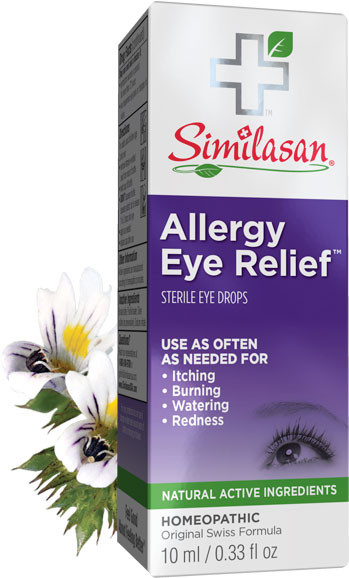
AllergyCalm™ by Boiron
Uses homeopathic ingredients to target multiple allergy symptoms. Contains
- Allium cepa
- Ambrosia artemisiifolia
- Euphrasia officinalis
- Histaminum hydrochloricum
- Sabadilla
- Solidago virgaurea
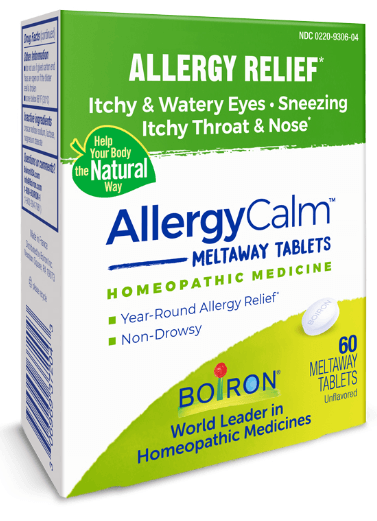
Supplements
Quercetin
Quercetin is a flavonoid that can be found in many plant foods. It inhibits both the manufacture and release of histamine and other allergic/inflammatory compounds. Quercetin works in the same way as an antihistamine but can be used for a longer period of time without side effects. It also supports the system when combating symptoms from many different types of allergies and asthma.
Bromelain
Often used in combination with quercetin, bromelain is an anti-inflammatory enzyme found in pineapples. It can help reduce inflammation and swelling that accompany allergic reactions.
Vitamin C
Make sure to take lots of vitamin C to help support and maintain healthy mucous membranes. Vitamin C also acts as an antihistamine, helps stabilize mast cells, and improves the effectiveness of quercetin.
N-Acetyl Cysteine
NAC is an antioxidant that comes from the amino acid L-cysteine. It has been shown to help thin mucus, making adhesive mucus water-soluble and easier to flush out of the system.
Recommended Products
D-Hist by Ortho Molecular
Contains vitamin C, quercetin, bromelain, stinging nettles leaf, and N-acetyl cysteine. The powerful combination actively promotes healthy nasal and sinus passages for individuals with elevated histamine and respiratory irritation.
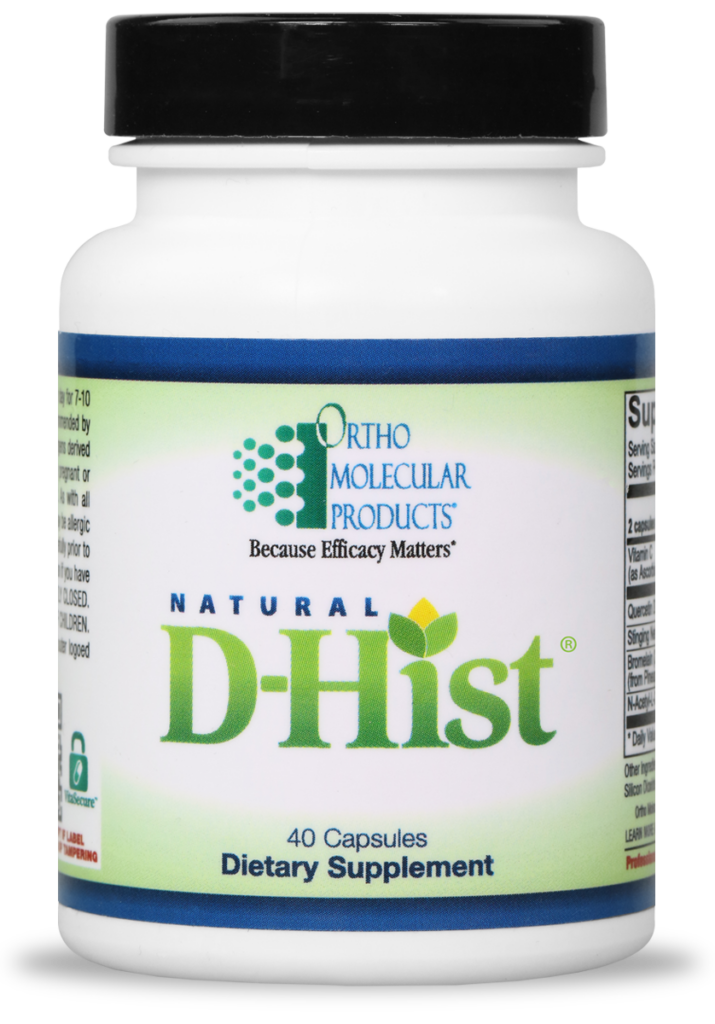
Allergy Health by Emerald Labs
Contains vitamin C, quercetin, nettle leaf powder, N-Acetyl Cysteine, Bromelain, and eyebright herb powder. It addresses multiple symptoms, boosts immunity, and lessens inflammation.
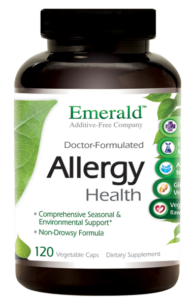
AllQlear by Integrative Therapeutics
Contains a proprietary blend of quail egg and quercetin. Quail egg contains ovomucoids which act as a tryptase inhibitor, supporting the healthy stabilization of mast cells.
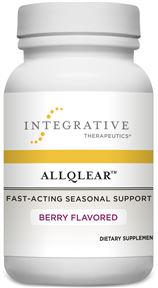
Herbals
Herbals are great when used as a tea, which can be enjoyed throughout the day. Teas can be made with a single herb or a combination. For added protection, start drinking herbal teas as allergy season approaches.
Eyebright
Reduces congestion and relieves itchy eyes and sneezing.
Dong Quai
Used as an antihistamine and has anti-inflammatory properties.
Milk Thistle
Reduces allergic reactions and has anti-inflammatory and antihistamine properties.
Stinging Nettle
Stinging nettle is another natural antihistamine. It can be used for both allergies and insect bites.
Essential Oils
Essential oils are great for reducing inflammation and boosting the immune system. They can be inhaled through a diffuser, applied to the skin or taken internally. Various oils can be mixed to remedy multiple symptoms. Be sure to research the best application method for each oil and symptom.
Basil Oil
Reduces the inflammatory response to allergens and supports the adrenal glands. Your adrenal glands supply many hormones that drive almost every body system.
Eucalyptus Oil
Relieves congestion by opening up the lungs and sinuses and has anti-inflammatory and analgesic effects. It can be added to your neti pot during sinus irrigation (see “Other Remedies” below), inhaled through a diffuser.
Lemon Oil
Supports lymphatic system draining, inhibits bacterial growth, detoxifies, and boosts the immune system. It also has disinfectant properties which can help keep your air clean and less prone to triggering reactions.
Peppermint Oil
When inhaled, peppermint oil often unclogs sinuses immediately and soothes throats. It also has anti-inflammatory properties and expectorant effects.
Tea Tree Oil
Has antiseptic and antimicrobial properties that can destroy airborne pathogens that cause allergies. It also has anti-inflammatory properties.
Other Remedies
Neti Pot
For those of you not familiar with them, neti pots are specially designed containers used to rinse mucus from your nasal cavity. A lukewarm salt water solution is used for irrigation which both clears the nasal cavity and increases the effectiveness of the cilia. Cilia are the hair-like structures that move mucus and allergens out of the nasal and sinus cavities.
Apple Cider Vinegar
Apple cider vinegar has an array of nutrients that help clear sinus cavities and treat allergy symptoms, including thinning mucus. Try using apple cider vinegar and water in your neti pot instead of salt water (2 tablespoons vinegar to 1 cup warm water). Vinegar has antifungal, anti-inflammatory and antibacterial properties that can help clean up the sinus cavity and prevent or treat an infection. Direct consumption of apple cider vinegar can also have therapeutic effects.
Local Raw Honey or Bee Pollen
Bees collect pollen from local plants – the same pollen that you’re reacting to. Eating local raw honey or bee pollen daily can help your body build up a tolerance to the allergens. The more local you can get, the better. If you can’t find bee pollen, ask around at your local farmer’s market.
Important Note On Natural Remedies
Be careful when choosing natural remedies as some may actually cause allergic reactions. It’s important to talk to a wellness professional who knows about the compounds used in the treatment. They can help you determine if you could have sensitivities.
When should you see a doctor?
A lot of people control their allergies on their own through over-the-counter medication, natural remedies, and reducing their exposure (closing windows during high pollen days, removing pollen from hair and clothes, etc). It’s time to see a doctor when these measures no longer help, symptoms are interfering with your day-to-day comfort, or symptoms become severe. Be prepared to bring a list of all of your symptoms, what treatments you’ve used, and when your allergies flare. Also, share how allergies have negatively impacted your life. Exercise limitations, lack of focus, and problems sleeping are all an important part of the picture.



